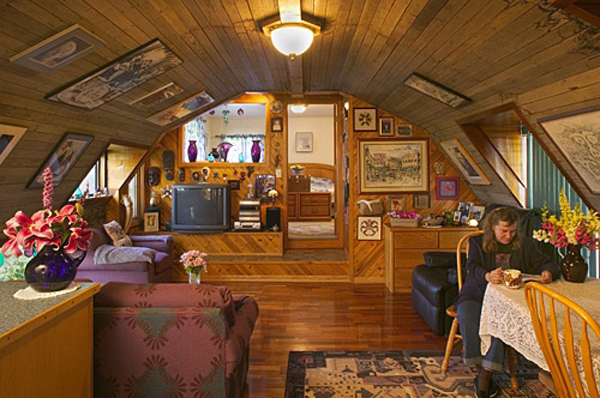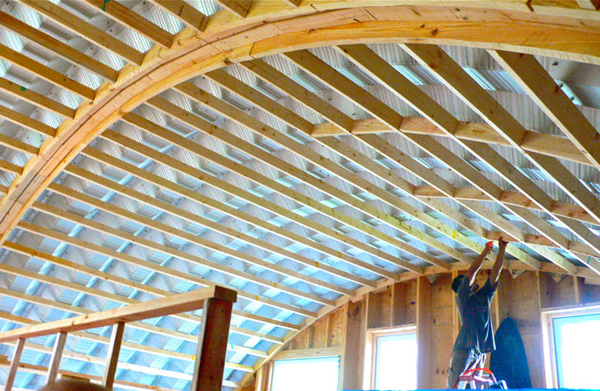
Steel quonset structures or ‘culvert homes’ are usually not rated for underground residential use. From what I’ve heard, most quonset hut manufacturers will not sell to anyone who intends to bury the structure. Covering a building with earth adds enormous weight on the structure and manufacturers don’t want any liability issues in case of collapse. This is unfortunate because quonset structures are well suited for underground homes, rootcellars and storm shelters. For one, they’re quick and easy to build. The main step involved is bolting the arched sections together with cordless drills.
If you’re interested in building something like this, I suggest finding the strongest quonset you can find and then consult with an engineer on the loads it can carry. There’s a good chance additional reinforcement will be recommended. Offhand, I can think of four general ways of reinforcing quonset structures for underground use.
1. Put concrete reforcing mesh (remesh) and concrete on the outside. This method is fairly common and may be the easiest approach for most do-it-yourselfer owner-builders.
2. Add mesh and spray shotcrete on the inside of the quonset.

The next two options will likely require supports perpendicular to the beams or trusses. Hire an engineer to do the necessary structural design.
3. Interior wood framing (see photo above). Wood is easier for owner-builders to work with than concrete and steel, and so this option has good potential for those seeking to bury or add earth-sheltering on their quonset structure. Wood framing also makes it easier to add plumbing, electrical, insulation and finish the interior (paneling, sheetrock, etc.).
4. Weld custom trusses with girders on top to reinforce the structure. This would get expensive unless you do your own welding and have access to affordable materials. Some quonset manufacturers may sell trusses and girders for this purpose. Most likely you’d have to either do the work yourself or buy from a local shop.
Note: If you can’t find thick steel quonsets that are strong enough for burial and don’t want to use the other options listed above, then consider buying concrete culvert pipe.
Also consider orienting a quonset so it’s long axis is east/west. Add a greenhouse on the south side (in the northern hemisphere) so the home is bathed in sunlight and warmth.
Another option is to join quonsets side by side with south facing window walls to maximize solar gain. This configuration would look sort of like the letter M in the McDonald arches.
Image source: Squidoo
Image source: Hatchworks
10 Really Cool Quonset Homes
Kelly Hart’s insulated carriage house (includes a nice workshop and large loft with office)
Quonset Hut: Metal Living for a Modern Age
Montana Quonset Home buried in a scoria hill (talk about an insulated home!)
The Culvert House

Has anyone built or considered a CONCRETE Quonset structure? Pro’s and con’s?
It is certainly possible to build a concrete quonset-shaped building, and as suggested in this blog post, a steel one can act as a form for a ferrocement covering. Pro’s include durability and fairly economical. Con’s include use of cement (high carbon footprint) and the work to form the shape with sufficient reinforcement and mix and apply the concrete.
yes, I have considered it. I was thinking about building one in the Flathead Valley in Montana to capture the southern sun in the winter. drlive7@yahoo.com
The wood framing in my opinion is paramount for electrical, plumbing, and insulation. I am also concerned about exterior rust, over time.
Does anyone know if Quonset huts or any metal building has add on extension so you could add on later if you needed a bigger building? If so can you please name the business? Thank you:)
Virtually all manufacturers of quonset style metal buildings will sell additional sections that can be bolted on to an existing building. That is one of the beauties of this technology…they can be as long as you want, just by adding more sections.
A close friend of mine is seeking to design an Earth-sheltered Quonset hut in the near future. I am a CADD Engineer that will be doing much of the design drawings for him. I am seeking any detailed design info available for this project. Thanx.
We’re also looking for an engineer who can work with us on a quonset hut covered in earth! Can you reach out to me? 239-910-5099
Did you conclude your design efforts? Was it constructed thereafter?
Was it permitted or inspected?
Wm Laubner, CedarKnollHomes
Cedarknollhomes@outlook.com
Steel Quonset structures fast and easy to construct, the structure can withstand heavy wind and much more strong.
How did you get the lumber to curve like that to match the quonset without splitting or breaking? I’m looking into quonset homes as a residence and trying to find out how I would add drywall for finishing to a metal building.
It appears to me that those major curved supports were cut with a band saw from much larger pieces of wood. You can’t really curve dry wall very easily, although I’ve seen people attempt this by scoring one side enough to make a faceted curve.
You can see what I did once with a steel quonset at http://dreamgreenhomes.com/plans/carriagehouse.htm, but this wasn’t buried.
Drywall can easily made to be curved. My best friend and his company did it all the time for stores in malls, churches, offices and homes.
The Quonset would be a rather easy job because the most Quonsets the bends are quite simulate.
METHOD: use saw horses or fabricate a fixture replicating the angle, lay the sheet of drywall in it, wet the backside and leave it over night. Next day the drywall is dried and bent to the shape you wanted. He would do 10/15 sheets each night.
It’s time consuming but is easy and makes drywalling curved walls a simpler job.
Wonder buildings are made to be placed as Earth covered – they make them for aircraft bunkers for the USAF
My dad is replacing his shop this year and is looking to put in a Quonset metal shop in its place. I have been looking around on the internet at different places to buy this building, but I am getting really bogged down looking at literally hundreds of different places to buy from. We are planning on putting the building up ourselves and it’s only going to be about 25ft by 30ft or so. I was wondering if you knew if these types of sites – http://quonset-hut.com/ can give accurate prices?
Thanks
They’re all pretty much the same. Buy from a reputable supplier near you to reduce shipping costs. Suppliers provide free cost estimates and engineering.
American Shelter sells a steel arch building designed for residential use and earth sheltering http://www.americansheltertechnologies.com/s_c_earth_covered.html
It is too bad they are not in business any longer.
England still sells them
Where are they sold in England and who by?
I suggest googling for this information.
http://www.subsurfacebuildings.com best I can do years later :)
I am considering a quonset shape built of arched REBAR TRUSSES (bar joists)…
I am considering a quonset shape built of arched rear tresses, cattle panels, hardware cloth, & cement (ferrocement).
Want to do a 30′ X 30′ (more or less)…
One other crazy thought I aam considering is to build a green house of same shape over the aforesaid structure for multiple reasons, none of the least of which is to provide a thermal wrapping for energy savings/comfort… & FOOD.
Any suggestions?
That’s a pretty big structure. I would first do lots of research (most everything is free online at places like Flying Concrete). And then build a fairly small test structure such as a tool shed. Gradually build larger structures as you improve your skill.
I’ve given a lot of thought to converting a steel building to home/shop use. The photo of the wood clad interior is nice but wouldn’t it be cheaper to spray foam on the interior walls? FYI, many sellers of these buildings have pictures of their kits with windows and doors, but read the fine print. Usually they are open ended, meaning You must provide your own doors and windows.
Every spray foam product that I’ve seen contains hazardous chemicals. It’s been a few years since I last checked, so you’ll need to do research the latest options. There may be some new products on the market now that are safe or what some may consider reasonably safe.
Spray foam might be acceptable in a shop, but would look awful in a home.
Also remember you can use recycled wood for the paneling.
The first photo shows the interior built with short, straight sections. The second photo shows a curved interior. Both are good options.
The general idea here is quonset structures give you a lot of bang for the buck. Even though they’re made of steel — a high embodied energy material — I still consider them a good option to consider, because they can last a lifetime, they’re easy to assemble and can be used to create zero energy homes, storm shelters, etc. at reasonable cost. They can be engineered to meet code if necessary.
Search quonset hut suppliers online and you’ll see they come in a variety of shapes.